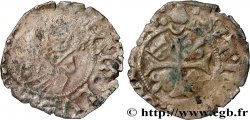Лицевая сторона
Аверс: легенда: + KAROLVS* FRANCORVM* REX, (PONCTUATION PAR SIMPLE MOLETTE À CINQ POINTES).
Аверс: описание: Écu de France entre trois couronnes dans un double trilobe.
Аверс: перевод: (Charles roi des Francs).
Обратная сторона
Реверс: легенда: + SIT* NOMEN* DNI* BENEDICTVM, (PONCTUATION PAR SIMPLE MOLETTE À CINQ POINTES).
Реверс: Описание: Croix dans un double quadrilobe cantonnée aux 1 et 4 d'un lis, aux 2 et 3 d'une couronne.
Реверс: перевод: (Béni soit le nom du Seigneur).
Комментарий
Историческая справка
CHARLES VIII
(30/08/1483-08/04/1498)
Born in 1470, son of Louis XI and Charlotte of Savoy, Charles girded the crown under the name of Charles VIII. The government fell first to his older sister Anne de Beaujeu, aged twenty-two, and to her husband, Pierre, who was forty-six.. The Beaujeus had to make concessions to public opinion: size reductions, dismissal of part of the army, trial of Olivier Le Daim, convocation of the Estates General. The latter met in Tours in 1484, without giving great results.. Power remained in Beaujeu, the former advisers of Louis XI remained in charge. A feudal coalition soon rose up against the Beaujeus, under the leadership of Louis d'Orléans, on the pretext of heavy taxes.. This "crazy war" of 1485 was reduced to a few military walks. The Breton feudals refused to support their Duke François II in the adventure. Richard III, King of England, external support of the rebels, was defeated and killed at Bosworth the same year. Maximilian, elected King of the Romans in 1486, joined the malcontents and the war resumed. In July 1488, the troops of François II were defeated at Saint-Aubin-du-Cormier and Louis d'Orléans was taken prisoner. His daughter, Anne de Bretagne, first married Maximilien by proxy, but soon had to give up this union: it was Charles VIII that she finally married in 1491.. Charles did not begin to reign until 1492, at the age of 22. It was towards Italy that his ambitions were directed. He thought of the conquest of the kingdom of Naples, where he took over the rights of the Angevins, a prelude to a crusade against Constantinople. Before going on the attack, he sought to neutralize his European adversaries: Treaty of Étaples of 1492, which bought the withdrawal of the English, who besieged Boulogne, Treaty of Barcelona of 1493, which ceded Roussillon and Cerdagne to Ferdinand the Catholic, Treaty of Senlis of the same year, which returned to Maximilien Artois, Franche-Comté and Charolais. The price of the Italian mirage was heavy even before the French had set foot in the Peninsula. On the death of Ferdinand of Naples (1494), Charles VIII concentrated his troops in Lyon. His army crossed the States of the Duke of Savoy and those of the other princes of Italy, powerless or accomplices. In February 1495, the king entered Naples. The kingdom was conquered without difficulty. In March, the Pope, Venice, the Duke of Milan, Maximilian, Ferdinand and Isabella formed the League of Venice. Charles left Naples in May, leaving Montpensier there as viceroy. He met the Allies, commanded by François de Gonzague, at Fornoue, in June 1495. The French forced the passage without undoing them. In October, Charles VIII had returned to France. The Kingdom of Naples rose soon after and the Aragonese dynasty regained its throne in 1497. Charles was preparing a second expedition when he died in April 1498, leaving no direct heir. The crown passed to his cousin, Louis d'Orléans.








 Cообщить об ошибке
Cообщить об ошибке Распечатать страницу
Распечатать страницу Отправить мой выбор
Отправить мой выбор Задать вопрос
Задать вопрос Consign / sell
Consign / sell
 Информация
Информация









